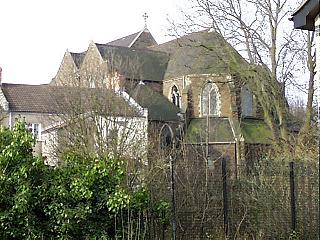 |
All Hallows EASTON Bristol |
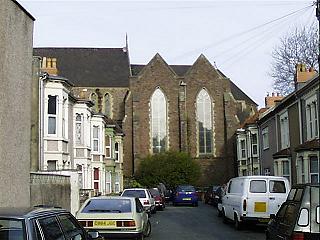 |
In a move not altogether popular with the vicar of St Mark those parts of his parish west of the Bristol-Cardiff/Severn Beach railway line was given over to the new church of All Hallows. St Mark may be the village church but definitely this is its town church daughter, tall stately and sadly never finished. It was begun in 1899 and completed in 1901. The architect was Sir George Oatley of the firm Crisp & Oatley.
Many people know it from the way it broods over the railway line between Lawrence Hill and Stapleton Road stations, in fact this is one of the best views of the church (left, above) but one only possible to photograph in the winter. Beyond the fence is the railway bed, once four tracks wide, and maybe so again soon if the proposed Bristol Suburban Railway ever gets built. From Easton Road one of the only other views of the church can be glimpsed long Brighton Park (above right). This road ends abruptly at the two gables of the south transept chapel. (Shame about the perspex covering on the windows, though)
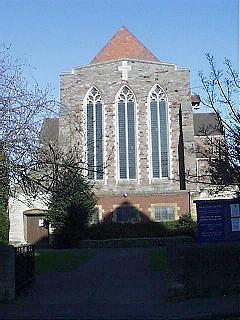 |
Of course there is another view, this one! This is the main west front of the building, viewed from All Hallows Road; the shadow is from the former Church Hall opposite, an impressive Arts & Crafts building, now a gymnasium. The front with its brick gable and narthex is not as planned. At least one more bay of the nave was to have been built but money ran out. However instead of leaving a bare brick wall - and probably in recognition that completion would never happen - three extremely handsome tall two-light windows with bath stone dressings set in grey pennant stone were built. This may have been the architect's original plans for the front "brought forward" as it were. If there was to have been a tower, such is the bulk of the church, it would have had to be mighty to compete. That would have added to the difficulty to photgraph status of the building, especially if it was to have stood here where the grassed courtyard garden is today. |
| This is the interior photographed in 1908 (with kind permission of Mr Bob Dickson). As you will see not too much has changed. The nave is 67 feet high, the chancel is treated as a crossing with very tall two-bayed arcades north and south. The east end is apsidal with two-light windows above the arches to the ambulatory (lit by a small window now covered by a curtain). | 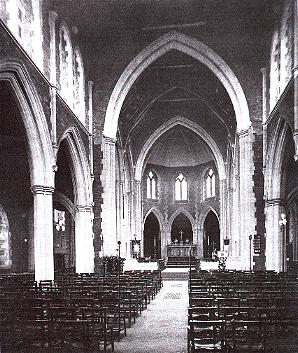 |
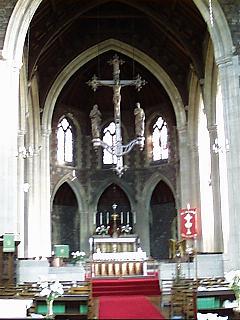 |
These two views show the interior in January 2001. There are more candles on the High Altar and a hanging rood. The tall arches to the "transepts" can also be seen here. The west bay of the north transept has a gallery with the large organ works upon. There are two outer chapels flanking the first bay of the apse | 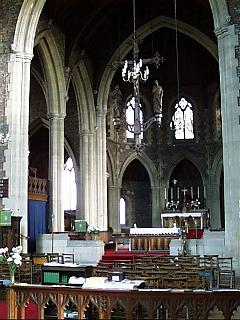 |
|
These views show the foreshortened nave. It is three bays long with a steeply gabled roof and arcades where the third pier to the west stands just in front of the west wall, the arch springing into it. The attention to detail is superb, and the dressed stone contrasts well with the exposed grey pennant inside. | 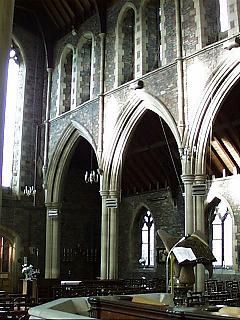 |
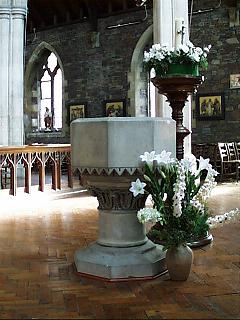 |
The font now stands in the west end of the nave, a rather plain octagonal bowl on a column carrying a lush French-style capital. Also the flowers were very nice on the day I visited! The pulpit is a bulky wooden affair with saints in niches, sitting directly on a low stone base. | 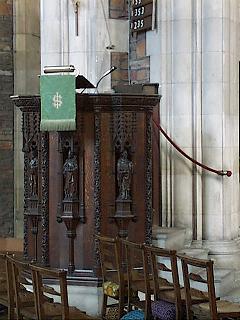 |
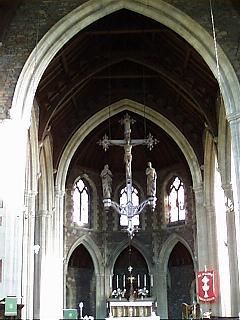 |
I like the rood especially, hence these two photos! The Bristol Times and Mirror, of Nov. 1901, says in its account of the dedication of All Hallows: "The front section consists of canopied recesses, the whole of the upper part being traceried and pinnacled. In the centre is a cross with sacred monogram above, and the Communion vessels are represented below. Two of the recesses contain angels in adoration, and the remainder has not yet been filled. The style of the church is that of English Gothic of the Decorative period, and its lines of composition will be found different from any other church in the city. |
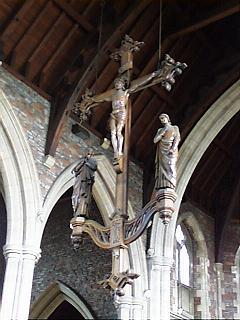 |
The exterior will be plain almost to severity, the chief object being to secure an effective interior. From the east end three bays have already been completed. There is an apsidal termination of the Sanctuary, with an ambulatory around it. The interior height of the church will at once appeal to those who visit the edifice, the lofty arches between the choir and the transepts adding considerably to this effect. The part of the scheme now carried out embraces the Sanctuary, choir, north and south transepts, and side chapel, and three bays of the nave. When the scheme is completed, two or three bays will be added, together with a western narthex. Available funds do not permit more than the provision of temporary choir stalls and pulpit. The walls are faced with red pennant, dressed with Bath stone, and the roofs will be open-timbered."
The church celebrated its centenary in 2001 and marked the occasion with a number of events, culminating in a Solemn Centenary Mass on Saturday 3rd November 2001 with the Bishop of Ebbsfleet as celebrant. There is also a book to mark the Centenary, published on 26th February 2001. Entitled "Hallowed be thy name; All Hallows 1901-2001" It was available from Bob Dickson at £4.50 each plus 80p Postage & Packing (U.K.) Further information and enquiries for postage outside of the U.K. to Bob Dickson, the book's editor. Please mention ChurchCrawler when you order!
Page updated 29th May 2009